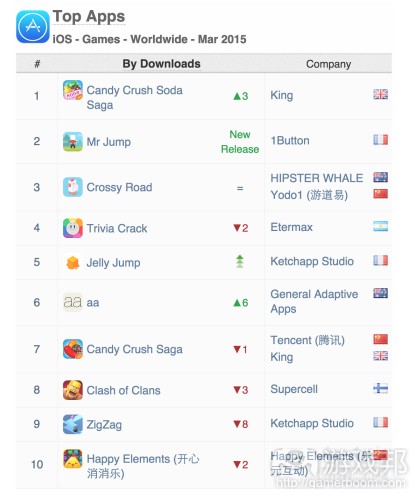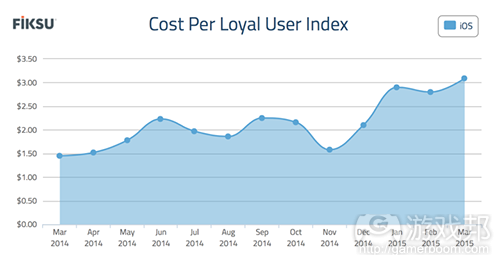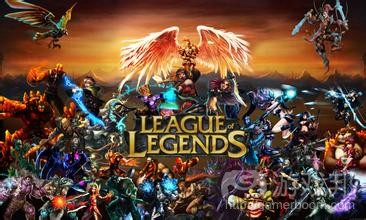每日观察:关注《Mr Jump》等iOS游戏排名(5.4)
1)据gamesbeat报道,新款游戏《Mr Jump》在App Annie三月份最热门iOS游戏下载榜单上晋升至第二名,仅次于King谜题游戏《Candy Crush Soda Saga》。
值得注意的是,于去年8月发布的谜题游戏《Aa》也攀升至榜单第六名,《Jelly Jump》则升至第五名。App Annie观察发现《Aa》和《Mr Jump》都属于超级休闲的游戏(只需一根手指即可操作),在2014年这些“超级休闲”有10个月的时间会占据每月榜单前十名。
2)据gamasutra报道,微软在本周开幕的Build开发者大会上展示了新款软件开发工具,支持iOS和Android等平台开发者“以最小的代码调整”,将自己的应用移植到Windows Store。
iOS开发者可以使用微软发布的Objective-C编译工具,重建自己的游戏令其运行于Windows 10 Mobile,在未来数月Android开发者也可以向Windows Store提交APK申请。届时这些开发者还可以在移植版本的游戏中绑定Xbox Live等微软功能。
除此之外,Windows Store也将重新设计成为用户所有Windows 10设备提供统一体验的平台,其理念类似于苹果App Store支持iOS平板电脑、手机和跨平台应用的做法。微软还致力于将Windows 10打造成“通用的Windows平台”,兼容PC、平板电脑、智能手机及该公司即将发布的新设备HoloLens耳机。
3)据gamasutra报道,Glu Mobile去年向手机平台推出的《Kim Kardashian Hollywood》大受欢迎,该公司最近宣布腾讯注资1.26亿美元,获得公司2100万份股票,掌握了公司14.6%的股份(venturebeat报道称此举令Glu Mobile目前身价达到8.63亿美元)。
除此之外,该公司还公布财报称第一季度收益为210万美元。
4)移动营销技术公司Fiksu最新数据显示,今年3月份iOS平台应用忠实用户获取成本同比上月增长30%,达到3.09美元(比去年期增长113%)。
除了去年11月份之外,这一数据从去年3月起一直在稳定增长。
除此之外,每安装成本(与广告相关的每应用安装成本)也增长至1.53美元,比去年增长46%。iOS和Android平台的每发布成本也分别增长至0.31美元和0.24美元,分别同比去年增长62%和135%。
Fiksu指出前200名免费iOS应用在3月份日均下载量为810万次,同比2月份下降16%,但比去年同期增长15%。
5)据venturebeat报道,微软首席执行官Satya Nadella在最近采访中确认了公司斥资25亿美元收购《Minecraft》开发商Mojang这一消息。
该公司收购Mojang是为了推进旗下的增强现实感设备HoloLens,今年初微软首次展示这一设备时使用的展示样本就是类似《Minecraft》的游戏,这两者的结合可以让用户宛如身临其境地接触游戏世界。
6)据gamaustra报道,King游戏《Candy Crush Saga》主创人员Tomy Palm日前表示自己新工作室Resolution Games(位于斯德哥尔摩)宗旨是制作“适用于所有家庭成员”的休闲虚拟现实游戏。
这家工作室有5名全职工作者和3名外包人员,Tomy Palm认为虚拟现实游戏与一般游戏设计一样,都可以放弃复杂的控制机制(无需玩家进行准确地输入),他们的游戏将更关注让玩家在游戏中进行探索,创造、解谜以及同角色互动。
7)Niko Partners最新报告显示,中国2015年网络PC游戏收益将增长22%,达到145亿美元,其中最受欢迎的是网络战斗竞技游戏和第一人称射击游戏,预计2019年该市场收益将达223亿美元。
报告指出中国本土发行商在MMO市场仍然占据优势,但Riot(《英雄联盟》)和Newiz(《穿越火线》)所占比例也有所增长。
2015年中国PC网络游戏玩家将达2.75亿,相当于88%的美国人口。(本文由游戏邦编译,转载请注明来源,或咨询微信zhengjintiao)
1)App Annie: Mr Jump leaps to second most-downloaded iOS game in March
Mike Minotti
Gaming execs: Join 180 select leaders from King, Glu, Rovio, Unity, Facebook, and more at GamesBeat Summit. This is an invite-only event so apply now!
The wordplay comes easily when a game called Mr Jump rises up a list.
That new iOS game debuted at No. 2 on App Annie’s list of most downloaded iOS games worldwide in March. Dare I say that it “jumped” up there? It was only behind King’s popular puzzle game Candy Crush Soda Saga. This makes it a big success story in a mobile market that could reach $30 billion and exceed the console industry’s revenues this year, according to market researcher Newzoo.
“Unlike so-called ‘endless’ runners, Mr Jump presents players with 12 distinct levels to jump through,” App Annie noted in its report. “Beating one level unlocks the next, although players can purchase keys to unlock the next level via in-app purchases.”
You can see the rest of App Annie’s list below.
app annie marchNotably, puzzle game Aa, which originally came out last August, has climbed up the charts to the No. 6 spot. The endless-jumper Jelly Jump also (again, forgive me) jumped up the charts to No. 5. App Annie categorizes games like Aa and Mr Jump as super casual, which means they only involve one input (a simple finger tap).
“App Annie reported that, in 2014, one or more ‘super-casual’ games were in the top 10 monthly charts 10 months out of 12,” said Stewart Rogers, analyst at VB Insight. “In addition to that success stirring the pot for other game developers, these titles lend themselves to the best performing monetization strategies detailed in John Koetsier’s recent Mobile Games Monetization study, such as in-app progress purchases.”
“Companies of all sizes are driving the popularity of super casual games,” App Annie noted. “The genre is simple enough for smaller companies to release quickly, while large companies can afford to plant dozens of super casual seeds to increase the chance of landing a viral hit. Thus, the genre continues to see strong growth. For the first time since Flappy Bird left its mark, half the games on the iOS Downloads rankings were super casual games.”(source:venturebeat)
2)Microsoft paves the way for devs to port iOS/Android apps to Windows
By Alex Wawro
Microsoft’s Build developer conference is taking place in San Francisco this week, and one of the company’s key messages for mobile developers seems to be: Please bring your games and apps to the Windows Store.
To jumpstart the porting process Microsoft is debuting new software development kits designed to allow iOS and Android developers (among others) to port their work to the Windows Store “with minimal code modifications.”
“The theme is to start with your current code base, and then extend,” Microsoft exec Terry Myerson told ZDNet. “We want to embrace devs where they are.”
To facilitate that, Microsoft is rolling out an Objective-C compiler that iOS developers can use to rebuild their games to run on Windows 10 Mobile. The company is also designing its upcoming mobile OS to support Android Open Source, and in a few months the company will begin accepting APK submissions from Android developers for the Windows Store.
The storefront itself is also being redesigned as a “single unified experience for Windows 10 customers across devices”, which sounds much akin to how the Apple App Store supports iOS tablet, mobile and cross-platform apps.
This is in line with Microsoft’s attempt to spin Windows 10 up into a “Universal Windows Platform” that encompasses PCs, tablets, smartphones and the company’s upcoming HoloLens headset.
The idea is that Windows Store apps will automatically adjust themselves to different supported platforms, and iOS/Android developers who use Microsoft’s new toolsets to port their work to the Windows Store will be able to integrate Windows features like Xbox Live into the Windows version of their games.(source:gamasutra)
3)Tencent buys $126 million stake in Kim Kardashian publisher Glu Mobile
By Christian Nutt
Last year Glu Mobile found major success with Kim Kardashian Hollywood on mobile phones, and everybody took notice — including us. It seems that Tencent, recently named as the biggest game company in the world by revenue, paid attention too.
Today, Glu announced that Tencent has invested $126 million in the company and walked away with 21 million shares — at $6 a pop. Tencent’s Steven Ma joins Glu’s board of directors as part of the deal. The purchase gives Tencent a 14.6 percent stake in the company.
Alongside this news, the company also announced it’s inked a deal with pop icon Britney Spears to a five-year deal for the development of a mobile game. It also announced its first quarter results today: The company posted a proft of $2.1 million for the quarter.
“Tencent was attracted to Glu due to its five-year growth track record, high-quality entrepreneurial management, and unique approach to methodically building a portfolio of success in the shooter, action-RPG, narrative-RPG, time-management, sports and racing genres,” Ma said in a statement.
Tencent, of course, has also made a number of investments in game companies over the last several years; it owns Riot Games, makers of League of Legends and has a major stake in Unreal Engine company Epic Games, too. It’s more recently invested in mobile studio Playdots, Robot Entertainment, and Miniclip.
Though Glu CEO Niccolo de Masi didn’t mention Chinese expansion as part of the deal, it seems likely that this will smooth Glu’s entry into that market — which is projected to overtake the U.S. as the biggest games market in the world this year. Kabam took a $120 million investment from Chinese web giant Alibaba last year, and this year announced its pivot toward that market.(source:gamasutra)
4)It costs more than $3 to acquire a mobile user now, Fiksu finds
Dale North
Successful CMOs achieve growth by leveraging technology. Join us for GrowthBeat Summit on June 1-2 in Boston, where we’ll discuss how to merge creativity with technology to drive growth. Space is limited. Request your personal invitation here!
Securing an app downloaded from a user is no longer the end game.
The cost of acquiring users for games and apps is up a notable 10 percent from last month and a scary 113 percent from last year, putting the number at $3.09. These figures from mobile marketing technology company Fiksu’s Cost Per Loyal User Index data, which measures the cost of gaining a user that opens an app three times, points to mobile marketing’s steadily rising importance — and costs.
Other than a bit of a dip in November, the CPLU index has steadily climbed since March of last year, where it started at less than half of where it stands now.
It’s all expensive: Fiksu’s Cost Per Install Index, which figures the cost per app install directly tied to ads, climbed to $1.53 on iOS this month, up 46 percent since last year. A similar index, Cost Per Launch, was up for both iOS and Android, at $0.31 and $0.24 respectively — up 62 percent and a whopping 135 percent year-over-year. It’s increasingly difficult to find new users as gaming grows, but spending to do is necessary to stay afloat in the $30 billion mobile games market.
Mobile User Acquisition: how the most successful developers get better users for less money
With the millions of available games on the App Store and Google Play, it’s easy to get crowded out as a free-to-play mobile title. These need a constant influx of new users to stay relevant — and to pay for the rising costs to continue the cycle.
“One of the big issues here is that, according to John Koetsier’s recent Mobile User Acquisition study, mobile app and game developers prefer cost per install (CPI) user acquisition techniques more than any other,” Stewart Rogers, analyst at VB Insight, said. “CPI may enable cost management against lifetime value (LTV) but it also attracts low-spending, and low quality, users. That in itself is driving the CPLU index up, since that group is the least likely to stick with the vendor’s app.”
The demand for apps also continues to climb. The Fiksu App Store Competitive Index tracks the average daily download volume of the top 200 free iOS apps. For March, it shows a 16 percent decrease since last month, but a 15 percent increase since last year. At 8.1 million downloads in March, mobile users are still hungry for apps.
“As we enter another record-breaking month, brands must face the inevitable rising tide: mobile marketing is maturing and becoming more expensive. To stay ahead of this evolving market, marketers must continually adjust and take advantage of programmatic media buying methods to spend marketing budgets as wisely as possible,” said Micah Adler, CEO of Fiksu in a statement. “Sustainable success will be found by brands that use more precise forms of targeting to reach the right mobile users: those who will engage with an app and become loyal over the long term.”(source:venturebeat)
5)Microsoft bought Minecraft for HoloLens, Nadella says
Jeff Grubb
Gaming execs: Join 180 select leaders from King, Glu, Rovio, Unity, Facebook, and more at GamesBeat Summit. This is an invite-only event so apply now!
Minecraft isn’t just that game your kids can’t stop talking about, it’s also a key piece of Microsoft’s most exciting new technology
Microsoft chief executive officer Satya Nadella has confirmed in an interview with the New York Times that HoloLens was one of the major reasons his company spent $2.5 billion on the Lego-like block-building game Minecraft and developer Mojang. HoloLens is an augmented-reality head-mounted display that puts “holograms” right in the real world that you can interact with and walk around. When Microsoft first showed off HoloLens earlier this year, one of the first demos was a Minecraft-style game that takes over your living room and blew our writer’s mind. It showed how the technology intermingles with the real world. Now, Minecraft will serve as a centerpiece of the HoloLens platform moving forward.
Minecraft is one of the few properties in the world that has the power to convince a generation of tech consumers to adopt something new. Gaming is the biggest app category on mobile, which was the last disruptive space, and Microsoft realizes it will need to make gaming work on HoloLens if the impressive hardware is going to change how humans interface with computers.
Nadella said that his team was looking for something that could demonstrate the power of HoloLens when it went to make the Minecraft deal.
“Let’s have a game that, in fact, will fundamentally help us change new categories,” said Nadella. “HoloLens was very much in the works then, and we knew it.”
Minecraft’s popularity is nearly unrivaled. Across PC, consoles, and mobile, people have downloaded Minecraft more than 60 million times. Despite first coming on to the scene in 2009 and releasing as a full game in 2011, the game continues to outsell most other software every month into 2015. It’s a phenomenon. Among the generation of children who grew up on it, it is like their Mario or Star Wars. It will forever shape their concept of what a video game is — and Microsoft now controls that and is using it to push ahead into something entirely new.
But combining Minecraft with HoloLens doesn’t just make sense because the game is popular and should benefit HoloLens in terms of sales. It makes sense because Minecraft is all about interactions and creations, and these are the concepts that Microsoft seems focused on when it comes to HoloLens. While the HMD is definitely capable of acting as a consumption device, Microsoft has spent much of its demonstration time showing how it works as a tool for productivity.
Minecraft, with its focus on building your own worlds, can potentially act as a great onboarding experience where young people who are intimately familiar with the workings of that game quickly learn the design and interaction language of working with holograms.(source:venturebeat)
6)Former Candy Crush frontman opens a studio to make ‘calmer’ VR games
By Alex Wawro
This week former King games guru and Candy Crush Saga frontman Tommy Palm made a show of unveiling his new Stockholm-based studio, Resolution Games, which he’s cofounded alongside a coterie of other Swedish game industry notables with the goal of making virtual reality games that are “accessible for the entire family.”
This isn’t the first time we’ve heard of Resolution — the self-funded 8-person studio (5 full-timers, 3 contractors) launched in January and Palm listed it on his CV last month while promoting his involvement with the Stugan game dev summer camp. But now the studio is making its mission clear: to make “casual” VR games.
“We believe that ‘calmer’ game action fits the VR platform better at this point,” Palm told Gamasutra, citing examples like a game where you move your head but not your body.
“I have yet to see an FPS that feels like it would work and not make me motion sick,” said Palm. “I think we all dreamt about VR where you would be free to roam an open world; that time has yet to come. But VR is still great for other game concepts.”
He went on to say that VR game design — and games in general — can gain much from forgoing complex control schemes with abstract inputs (press A to jump) in favor of intuitive movements like tapping on a screen or tilting your head.
“There are a lot of people out there that want to play VR games without necessarily shooting, chopping or blowing things up,” Palm told Gamasutra. “Our games will be more about exploring, creating, puzzle solving and interacting with characters.”(source:gamasutra)
7)China’s PC online gaming market revenues grew 22 percent to $14.5B in 2014 — MOBAs helped
Dale North
Successful CMOs achieve growth by leveraging technology. Join us for GrowthBeat Summit on June 1-2 in Boston, where we’ll discuss how to merge creativity with technology to drive growth. Space is limited. Request your personal invitation here!
China’s more open than ever to foreign-made games.
Niko Partners‘ latest market report shows that online PC gaming revenues in China are up 22 percent this year, jumping to $14.5 billion due to an increased demand for online battle arena games and first-person shooters. The Asian games market intelligence says that such growth will continue as foreign game companies find success in the country, helping push revenues to a projected $22.3 billion in 2019.
The firm’s 2015 China’s PC Online Games Market Report shows that while domestic Chinese publishers still rule the MMO segment, foreign companies such as Riot (League of Legends) and Neowiz (CrossFire) are seeing increased adoption as MOBA and FPS games grow in popularity. As a result, e-sports is getting bigger, and professional gamers are becoming cultural icons. This is all happening on top of impressive mobile gaming growth in China.
The market is large enough for both, it seems.
“In 2015 there will be 275 million Chinese PC online gamers eager to connect with friends at home or in I-cafés – roughly equal to 88 percent of the current population of the United States,” said managing partner and founder of Niko Partners Lisa Cosmas Hanson in a statement. “While much of the casual game usage has migrated from PC to the mobile platform, the high quality client-based MMOGs and hardcore webgames continue to generate strong revenue in China’s enormous games market.”(source:venturebeat)











































 闽公网安备35020302001549号
闽公网安备35020302001549号